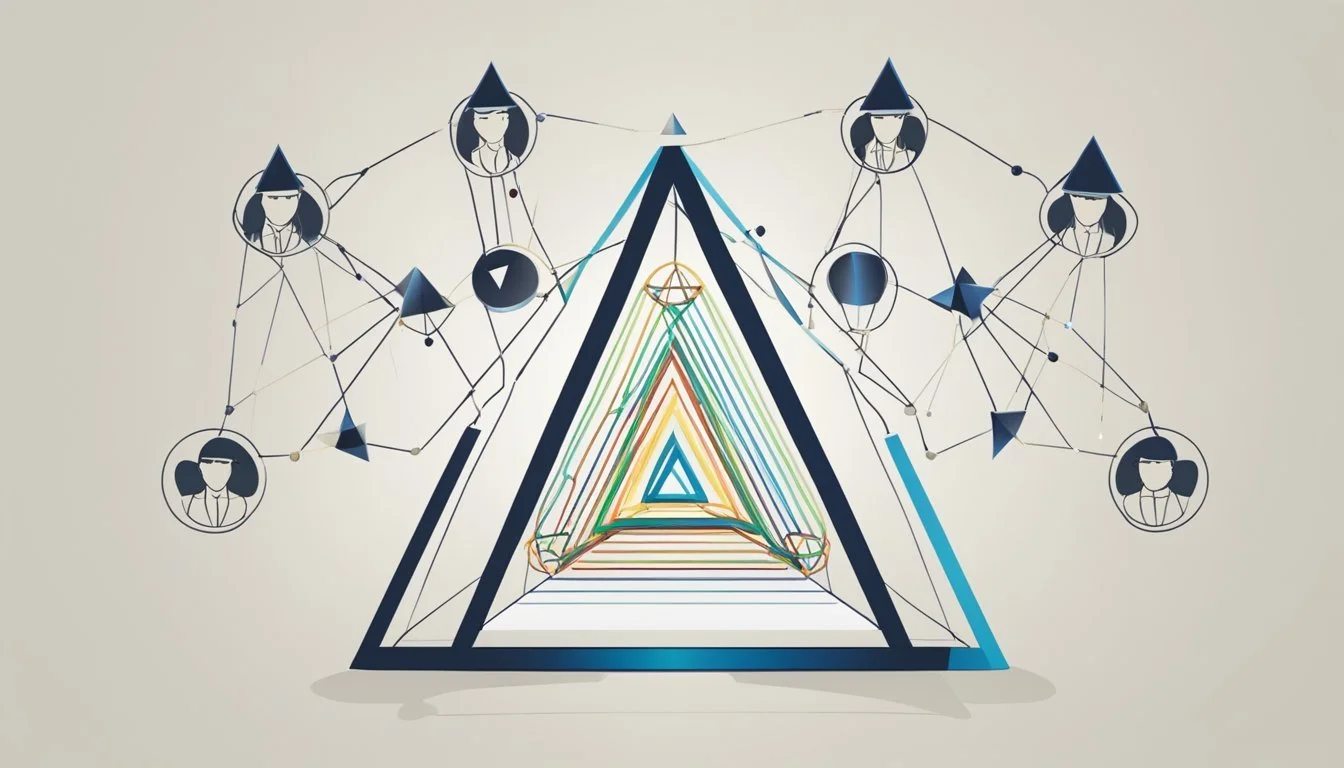9 Ways Narcissists Use Triangulation to Manipulate Their Children
Insights and Strategies
Narcissistic parents often employ various tactics to manipulate and control their children, creating complex and emotionally charged family dynamics. One of the most insidious methods they use is triangulation, a psychological manipulation strategy that involves drawing a third party into conflicts to gain power and control over the other two individuals.
Understanding how narcissists use triangulation can provide valuable insight into the dysfunctional behaviors that permeate toxic family relationships. Recognizing these patterns is crucial for identifying and addressing the negative impacts on the children involved, empowering them to seek healthier interactions and emotional well-being.
1) Favoritism
Favoritism is a common tactic narcissistic parents use to manipulate their children. By showing preferential treatment to one child over others, these parents create an environment of competition and jealousy.
The favored child may receive more attention, praise, and privileges. This unequal treatment can lead to resentment and rivalry among siblings, which serves the narcissistic parent's need for control and power.
Narcissistic parents often use favoritism to pit children against each other. By doing so, they can isolate each child emotionally, making them more dependent on the parent for validation and support.
This divisive behavior ensures that the parent's authority remains unchallenged. The children, desperate for approval, may engage in behavior that aligns with the narcissist's expectations, further entrenching the controlling dynamic.
Favoritism as a form of triangulation is a subtle, yet effective, manipulation strategy. It disrupts healthy sibling relationships and fosters an atmosphere of insecurity and mistrust within the family.
2) Gaslighting Siblings
Narcissists often employ gaslighting to manipulate their siblings. This involves making the sibling question their reality or memories. By consistently denying events or facts, the narcissist creates confusion and self-doubt in the sibling.
Gaslighting can manifest in various ways. The narcissist may flatly deny having said or done something hurtful, even when the sibling clearly remembers it. This tactic aims to make the sibling unsure of their perceptions.
The narcissist might also invalidate the sibling's feelings by calling them overly sensitive or irrational. This undermines the sibling's emotional experiences and erodes their self-esteem.
In some cases, the narcissist might use subtle manipulation, like pretending to forget important events or obligations. This can make the sibling feel neglected and undervalued.
Narcissists may also use more blatant forms of deception. For example, they might fabricate stories to paint themselves as the victim and the sibling as the aggressor. This can isolate the sibling and damage their relationships with other family members.
Gaslighting can have long-term psychological effects, leading to anxiety, depression, and a diminished sense of self-worth. Recognizing the signs of gaslighting is crucial for siblings to protect their mental health. Understanding these dynamics can help siblings set boundaries and seek support.
For more detailed information on how narcissists treat their siblings, 8 Ways That Narcissists Treat Their Siblings offers valuable insights.
3) Comparisons to Other Parents
Narcissistic parents often manipulate their children by making constant comparisons to other parents. This can diminish a child's self-esteem.
Such parents highlight other parents' achievements or perceived superiority to emphasize the child's perceived inadequacies. This tactic sows doubt and insecurity in the child about their own worth.
The narcissistic parent may portray themselves as the only parent with appropriate standards or values. By doing this, they isolate the child from forming healthy bonds and relationships with others, including their co-parent.
Constant comparison can lead the child to feel they can never measure up. The child's self-worth becomes tied to an impossible standard set by the narcissistic parent's skewed view of others. More on this dynamic can be found in 13 Ways Narcissistic Parents Sabotage Their Children.
Frequent comparisons also serve to glorify the narcissistic parent. They may frame themselves as superior and entitled to admiration, making the child strive harder for approval. This reinforces the parent's control over the child's emotions and decisions.
These tactics cause long-term emotional harm, often leaving the child struggling with issues of self-worth and identity well into adulthood.
4) Manipulation via Guilt
Narcissistic parents often use guilt as a tool to manipulate their children. They might highlight sacrifices made for the child, creating an emotional burden on the child to comply with their wishes.
These parents may remind the child of past favors or support provided, implying that the child owes them. This can lead to the child feeling obligated to act in ways that please the parent, disregarding their own needs.
Manipulating through guilt often involves twisting narratives to make the child feel responsible for the parent's happiness or well-being. This tactic diminishes the child's autonomy and can create a cycle of compliance driven by emotional coercion.
By leveraging guilt, these parents maintain control and ensure the child's actions align with their desires. This manipulation can have lasting impacts on the child's emotional health and sense of self.
Understanding how guilt is used can help individuals recognize and address these manipulative behaviors. Recognizing the pattern is the first step towards fostering healthier relationships and personal autonomy.
5) Divide and Conquer Tactics
Narcissistic parents often use divide and conquer tactics to manipulate their children. They may pit siblings against each other to maintain control and prevent unity. By creating rivalries and fostering competition, they keep their children preoccupied with internal conflicts instead of scrutinizing the parent's behavior.
Such tactics include spreading false information or emphasizing one child's achievements over another's. This creates jealousy and discord among siblings. For instance, praising one child excessively in front of the other can create feelings of inadequacy.
The narcissist may also play one child as the "golden child" and the other as the "scapegoat." This favoritism breeds resentment and competition. The golden child may strive to maintain their favored status, while the scapegoat child feels perpetually inadequate and neglected.
By keeping children emotionally dependent on the parent's approval and validation, the narcissistic parent ensures ongoing control. This manipulation strategy serves to weaken the bonds between siblings, making it easier for the parent to dominate each child individually.
The divide and conquer method serves to distract the children from the narcissist's faults. It reinforces the parent's perceived superiority and keeps the children's focus on earning favor, rather than questioning the fairness of their treatment. Such tactics disrupt family harmony and ensure the narcissist remains the central figure of power.
6) Projection
Projection is a defense mechanism where narcissists attribute their own negative traits or behaviors to others. This helps them deflect blame and avoid accountability.
In the context of triangulation, a narcissistic parent might accuse their child of being selfish or ungrateful. The parent is actually projecting their own attitudes and behaviors onto the child.
This tactic not only confuses the child but also makes them doubt their own perceptions and feelings. The child may start to internalize these false accusations and believe that they are the problem.
The narcissist might also manipulate a third party, such as a sibling or another family member, to reinforce these projections. This creates an environment where the child feels isolated and misunderstood.
By involving a third person, the narcissistic parent strengthens their control over the situation. The child struggles to defend themselves against the baseless accusations and feels trapped.
Projection in triangulation is a powerful tool for narcissists to maintain dominance and keep their children insecure. Recognizing this tactic can be the first step towards breaking free from its harmful effects.
For more information on dealing with narcissistic projection, you can visit Narcissistic Projection which provides examples and strategies.
7) Blame Shifting
Blame shifting is a tactic narcissists use to evade responsibility. They deflect their own errors onto others, often making their children feel at fault. This manipulation causes confusion and guilt in the child.
Instead of acknowledging their mistakes, narcissists point fingers. An incident where a parent scolds a child for not cleaning, despite failing to provide clear instructions, exemplifies blame shifting.
Children manipulated in this way struggle with self-esteem. Constantly being blamed for the parent's shortcomings affects their confidence and emotional health.
Narcissists also use blame shifting during conflicts between the child and another parent. They may falsely accuse the child of instigating issues to divert attention from their own behavior. This tactic is frequently seen by those experiencing narcissistic abuse.
Blame shifting doesn't just harm the child's self-image; it also undermines their trust in others. By consistently making the child feel at fault, the narcissist creates a distorted perception of reality.
Understanding blame shifting helps in identifying and addressing such manipulative behaviors. Children who realize this pattern can seek support to mitigate its impact on their well-being.
8) Using Third-Party Validation
Narcissists often use third-party validation to manipulate their children by bringing in an external person to validate their perspective. This tactic can make the child doubt their own perception and trust more in the narcissist's narrative.
They may introduce a friend, family member, or even a professional to support their viewpoint. By doing so, they create a sense of legitimacy around their claims, making it harder for the child to challenge them.
This third-party figure may echo the narcissist's opinions or point out the child's "faults," reinforcing the narcissist's position. This can lead to confusion and a feeling of being ganged up on by the child.
Using a third party in this way also serves to isolate the child. The child might feel there's no one they can trust or turn to for an unbiased perspective. This isolation increases the child's dependence on the narcissist for validation and approval.
In this manipulative cycle, the third party may also be unaware they are being used as a tool. They might believe they are genuinely helping, which in turn strengthens the narcissist's control.
9) Silent Treatment
Silent treatment is a common tactic used by narcissistic parents to control their children. This involves deliberately ignoring the child, withholding communication, or withdrawing affection.
The narcissist uses silent treatment to instill feelings of guilt, anxiety, and confusion. The child may feel desperate to regain the parent's attention and approval. This imbalance of power serves the parent's need for control.
Silent treatment can be emotionally devastating for children. It communicates that they are unworthy of attention or love, which can lead to long-term emotional issues. Children may grow up feeling insecure or constantly seeking validation from others.
Parents who use silent treatment often deny its existence, making it difficult for children to understand and address the abuse. This can exacerbate feelings of isolation and helplessness.
By recognizing silent treatment as a form of manipulation, adult children of narcissists can take steps towards healing and establishing healthier boundaries in their relationships. They can also seek support from professionals who understand the dynamics of narcissistic abuse.
Understanding Triangulation
Triangulation is a manipulation tactic commonly used by narcissists to control relationships and create division. When directed at children, it can have profound emotional and psychological effects.
Definition and Mechanisms
Triangulation occurs when a narcissist introduces a third party into a relationship dynamic, creating a "triangle." This can be used to control and influence behavior. For example, a parent might compare one child unfavorably to another, fostering rivalry and insecurity.
Narcissists may also use triangulation to shift blame or divert attention from their own behaviors. By positioning themselves as the victim or the superior party, they manipulate the perceptions and emotions of the children involved.
This tactic isn't always malicious; sometimes, it's a deeply ingrained behavior stemming from the narcissist's own insecurities and need for control. Importantly, it creates a toxic environment where trust and healthy communication are undermined.
Psychological Impact on Children
Children involved in triangulation often experience confusion and emotional distress. They might feel pressured to compete for parental approval or align with one parent against another.
This manipulation can lead to long-term psychological effects. Affected children may struggle with self-esteem, experiencing feelings of inadequacy or unworthiness. They might also develop trust issues, finding it difficult to engage in healthy relationships later in life.
In addition, children may internalize the conflict, feeling responsible for family tensions. This can lead to anxiety and depression, impacting their overall well-being. Awareness of these impacts can be crucial in addressing and mitigating the harm caused by narcissistic triangulation.
Signs of Triangulation in Family Dynamics
Triangulation in family dynamics often manifests through specific behaviors and emotional manipulation tactics. Identifying these signs can help in recognizing the presence of narcissistic control within the family.
Behavioral Indicators
One of the key signs of triangulation is altered communication patterns. The narcissist often communicates through a third person rather than addressing family members directly. This indirect approach maintains control and introduces confusion.
Another indicator is favoritism. Narcissistic parents may openly favor one child over others, creating competition and discord among siblings. This favoritism is not consistent and can change, keeping children on edge.
Isolation is a significant behavioral indicator. The narcissist might isolate certain family members to weaken their relationships with others. This isolation ensures that the narcissist remains central and indispensable in family interactions.
Emotional Manipulation
The emotional manipulation in triangulation is subtle yet profound. Narcissists may play the victim in front of one child while portraying another family member as the villain. This tactic sows seeds of distrust and loyalty toward the narcissist.
Gaslighting is another common method, where the narcissist denies past events, causing family members to question their own memories and perceptions. This manipulation further entrenches the control of the narcissist.
Additionally, guilt-tripping and emotional blackmail are used to coerce family members into compliance. Narcissists may threaten to withdraw love or support if their demands are not met, creating a cycle of dependency and fear.
Identifying these signs requires a keen observation of family interactions and emotional responses. Understanding these patterns can lead to more effective coping and intervention strategies.
Long-Term Consequences
Children subjected to narcissistic triangulation often suffer significant long-term effects. These impacts manifest in both their mental health and the quality of their relationships in adulthood.
Effects on Mental Health
Narcissistic triangulation can severely damage a child's mental well-being. Such manipulation often leads to chronic anxiety and depression, as the child is constantly put in a position of emotional conflict. The child may also develop low self-esteem and a persistent sense of unworthiness.
This emotional turmoil can result in difficulties with emotional regulation, making it hard for them to manage stress and respond appropriately to emotional stimuli. Symptoms like sleep disturbances, high stress levels, and a propensity for self-isolation are common.
Therapists often observe that these children become more susceptible to mental health disorders, including post-traumatic stress disorder (PTSD) and complex trauma. Long-term therapy might be required to address these deep-seated issues and help the individual develop healthier coping mechanisms.
Relationship Challenges in Adulthood
Adults who experienced triangulation as children frequently face challenges forming and maintaining healthy relationships. Trust issues are prevalent, as they’ve learned to be wary of intimate connections where they could be manipulated again.
They may struggle with communication, frequently doubting their perceptions and hesitating to voice their thoughts, fearing conflict. This issue often results in either an overly submissive stance in relationships or a quick-to-anger defensiveness.
Their relationships might often mimic the problematic dynamics of their past, either becoming too dependent on their partner or keeping them at an emotional distance. Therapy is essential in breaking these patterns, teaching them to establish boundaries, and fostering mutual respect in relationships. The healing process can be lengthy but is crucial for gaining healthier interpersonal skills.






